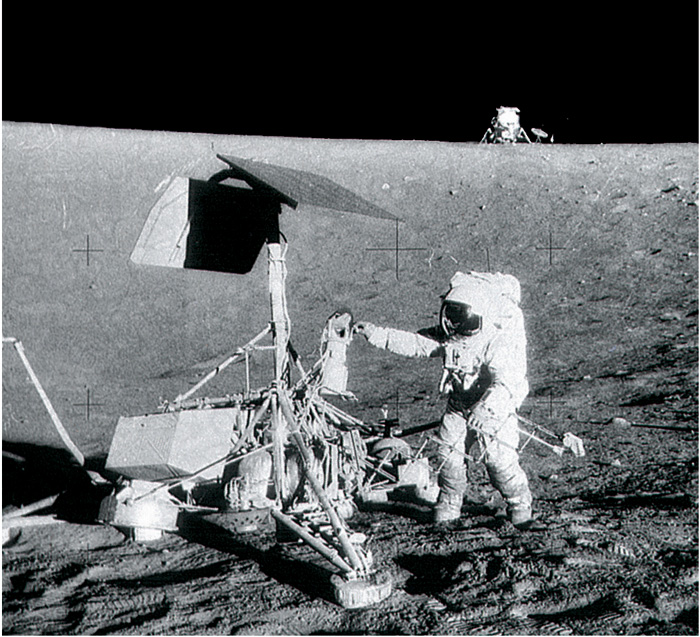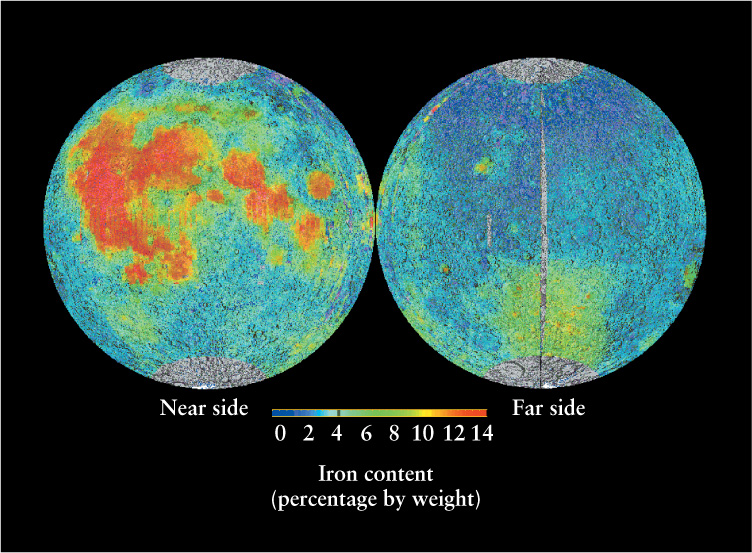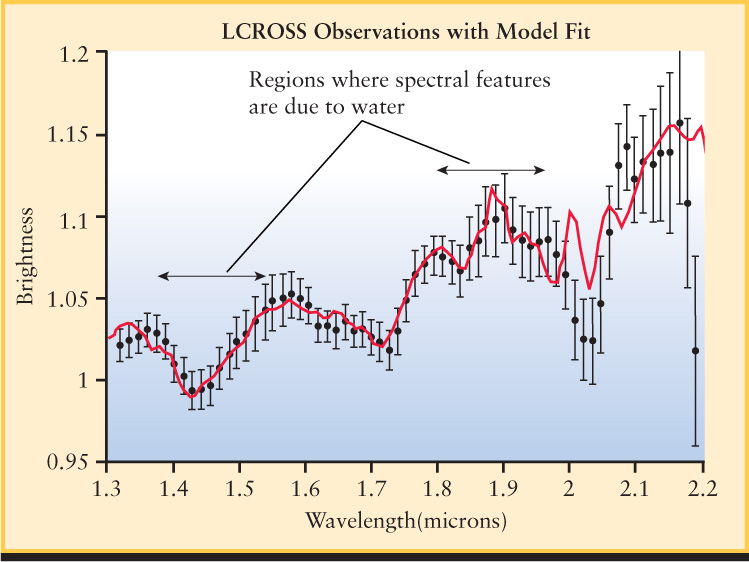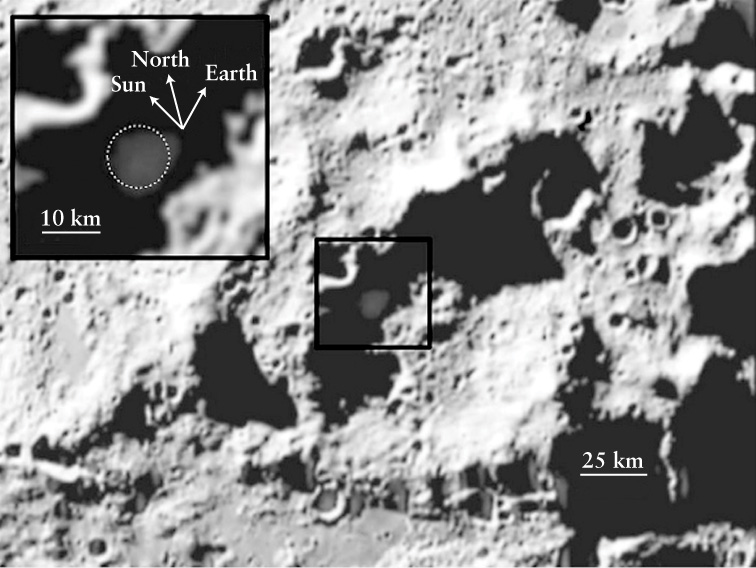10-2 Human exploration of the Moon in the 1960s and 1970s has been continued by robotic spacecraft
The Moon is the only world other than Earth to be visited by humans
 For thousands of years, storytellers have invented fabulous tales of voyages to the Moon. The seventeenth-century French satirist Cyrano de Bergerac wrote of a spacecraft whose motive power was provided by spheres of morning dew. (After all, reasoned Cyrano, dew rises with the morning sun, so a spacecraft would rise along with it.) In his imaginative tale Somnium, Cyrano’s contemporary Johannes Kepler (the same Kepler who deduced the laws of planetary motion) used the astronomical knowledge of his time to envision what it would be like to walk on the Moon’s surface. In 1865 the French author Jules Verne published From the Earth to the Moon, a story of a spacecraft sent to the Moon from a launching site in Florida.
For thousands of years, storytellers have invented fabulous tales of voyages to the Moon. The seventeenth-century French satirist Cyrano de Bergerac wrote of a spacecraft whose motive power was provided by spheres of morning dew. (After all, reasoned Cyrano, dew rises with the morning sun, so a spacecraft would rise along with it.) In his imaginative tale Somnium, Cyrano’s contemporary Johannes Kepler (the same Kepler who deduced the laws of planetary motion) used the astronomical knowledge of his time to envision what it would be like to walk on the Moon’s surface. In 1865 the French author Jules Verne published From the Earth to the Moon, a story of a spacecraft sent to the Moon from a launching site in Florida.
Almost exactly a hundred years later, Florida was indeed the starting point of the first voyages made by humans to other worlds. Between 1969 and 1972, 12 astronauts walked on the Moon, and fantasy became magnificent reality.
The First Spacecraft to the Moon
As in Verne’s story, politics had much to do with the motivation for going to the Moon. But in fact, there were excellent scientific reasons to do so. Because Earth is a geologically active planet, typical terrestrial surface rocks are only a few hundred million years old, which is only a small fraction of Earth’s age. Thus, all traces of Earth’s origins have been erased. By contrast, rocks on the geologically inactive surface of the Moon have been essentially undisturbed for billions of years. Samples of lunar rocks have helped answer many questions about the Moon and have shed light on the origin of Earth and the birth of the entire solar system.
Lunar missions began in 1959, when the Soviet Union sent three small spacecraft—Lunas 1, 2, and 3—toward the Moon. American attempts to reach the Moon began in the early 1960s with Project Ranger. Equipped with six television cameras, the Ranger spacecraft transmitted close-up views of the lunar surface taken in the few minutes before it crashed onto the Moon. These images showed far more detail than even the best Earth-based telescope.
In 1966 and 1967, five Lunar Orbiter spacecraft were placed in orbit around the Moon and made a high-resolution photographic survey of 99.5% of the lunar surface. Some of these photographs show features as small as 1 m across and were essential in helping NASA scientists choose suitable landing sites for the astronauts.
Even after the Ranger missions, it was unclear whether the lunar surface was a safe place to land. One leading theory was that billions of years of impacts by meteoroids and the solar wind had ground the Moon’s surface to a fine powder. Perhaps a spacecraft attempting to land would simply sink into a quicksandlike sea of dust! Thus, before a manned landing on the Moon could be attempted, it was necessary to perform a trial landing of an unmanned spacecraft: The purpose of the Surveyor program was to land unmanned spacecraft on the Moon. Between June 1966 and January 1968, five Surveyors successfully touched down on the Moon, sending back pictures and data directly from the lunar surface. These missions demonstrated convincingly that the Moon’s surface was as solid as that of Earth. Figure 10-9 shows an astronaut visiting Surveyor 3, two and a half years after it had landed on the Moon.

 Visiting an Unmanned Pioneer Surveyor 3 landed on the Moon in April 1967. It was visited in November 1969 by Apollo 12 astronaut Alan Bean, who took pieces of the spacecraft back to Earth for analysis. (The Apollo 12 lunar module is visible in the distance.) The retrieved pieces showed evidence of damage by micrometeoroid impacts, demonstrating that small bits of space debris are still colliding with the Moon.
Visiting an Unmanned Pioneer Surveyor 3 landed on the Moon in April 1967. It was visited in November 1969 by Apollo 12 astronaut Alan Bean, who took pieces of the spacecraft back to Earth for analysis. (The Apollo 12 lunar module is visible in the distance.) The retrieved pieces showed evidence of damage by micrometeoroid impacts, demonstrating that small bits of space debris are still colliding with the Moon.
263
That’s One Small Step for Man…
 The first of six manned lunar landings took place on July 20, 1969, when the Apollo 11 lunar module Eagle set down in Mare Tranquillitatis (Sea of Tranquility) seen in Figure 10-6. Astronauts Neil Armstrong and Edwin “Buzz” Aldrin were the first humans to set foot on the Moon. Apollo 12 also landed in a mare, Oceanus Procellarum (Ocean of Storms). The Apollo 13 mission experienced a nearly catastrophic inflight explosion that made it impossible for it to land on the Moon. Fortunately, titanic efforts by the astronauts and ground personnel brought it safely home. The remaining four missions, Apollo 14 through Apollo 17, were made in progressively more challenging terrain, chosen to permit the exploration of a wide variety of geologically interesting features. The first era of human exploration of the Moon culminated in December 1972, when Apollo 17 landed in a rugged region of the lunar highlands. Figure 10-10 shows one of the Apollo bases.
The first of six manned lunar landings took place on July 20, 1969, when the Apollo 11 lunar module Eagle set down in Mare Tranquillitatis (Sea of Tranquility) seen in Figure 10-6. Astronauts Neil Armstrong and Edwin “Buzz” Aldrin were the first humans to set foot on the Moon. Apollo 12 also landed in a mare, Oceanus Procellarum (Ocean of Storms). The Apollo 13 mission experienced a nearly catastrophic inflight explosion that made it impossible for it to land on the Moon. Fortunately, titanic efforts by the astronauts and ground personnel brought it safely home. The remaining four missions, Apollo 14 through Apollo 17, were made in progressively more challenging terrain, chosen to permit the exploration of a wide variety of geologically interesting features. The first era of human exploration of the Moon culminated in December 1972, when Apollo 17 landed in a rugged region of the lunar highlands. Figure 10-10 shows one of the Apollo bases.

The Apollo 15 Base This photograph shows astronaut James Irwin and the Apollo 15 landing site at the foot of the Apennine Mountains near the eastern edge of Mare Imbrium. The hill in the background is about 5 km away and rises about 3 km high. At the right is a Lunar Rover, an electric-powered vehicle used by astronauts to explore a greater radius around the landing site. The last three Apollo missions carried Lunar Rovers.
In a curious postscript to the Apollo missions, in the 1990s an “urban legend” arose that the Moon landings had never taken place and were merely an elaborate hoax by NASA. While amusing, this legend does not hold up under even the slightest scientific scrutiny. For example, believers in the “Moon hoax” cannot explain why the rocks brought back from the Moon are substantially different in their chemistry from Earth rocks, as we will see later in this chapter. Those arguing for a moon hoax simply say that the scientists, along with countless others involved in the lunar missions, are lying.
Between 1966 and 1976, a series of unmanned Soviet spacecraft also orbited the Moon and landed on its surface. The first landing, by Luna 9, came four months before the U.S. Surveyor 1 arrived. The first lunar satellite, Luna 10, orbited the Moon four months before Lunar Orbiter 1. In the 1970s, robotic spacecraft named Luna 17 and Luna 21 landed vehicles that roamed the lunar surface, and Lunas 16, 20, and 24 brought samples of rock back to Earth. The Luna samples complement those returned by the Apollo astronauts because they were taken from different parts of the Moon’s surface.
Recent Lunar Exploration and the Search for Water
While robots and probes can pursue scientific research in space more efficiently than humans, there might be other reasons for people to colonize space some day. Indeed, some countries have already outlined initial steps toward a lunar base in the coming decades. However, it is an expensive endeavor—it costs over $100,000 to transport the mass in a gallon of water to the Moon. Contemplation of a manned lunar base and the resources required to maintain it has added extra importance to the question, “Is there water on the moon?” To help answer this question, in 1994 a small NASA spacecraft named Clementine spent more than two months observing the Moon from lunar orbit. It carried an array of very high-resolution cameras sensitive to ultraviolet and infrared light as well as to the visible spectrum. Different types of materials on the lunar surface reflect different wavelengths, so analysis of Clementine images made in different parts of the electromagnetic spectrum has revealed the composition of large areas of the Moon’s surface. For example, the unique reflection signature of iron led to the iron-map in Figure 10-11.

264
One remarkable result of the Clementine mission was evidence for a patch of water-ice tens or hundreds of kilometers across at the Moon’s southern pole, in locations where sunlight never reaches and where temperatures are low enough to prevent ice from evaporating. Using a remarkable technique, radio waves beamed from Clementine were reflected off these areas and were then detected by radio telescopes on Earth! The reflected radio waves showed the unique signature of reflection from water-ice. Then, data from the Lunar Prospector spacecraft, which went into orbit around the Moon in 1998, reinforced the Clementine findings and indicate that even more water-ice might lie in deep craters at the Moon’s northern pole.
Encouragingly, the Lunar Prospector used a different measurement technique than Clementine, which strengthens the overall case for water. However, the Lunar Prospector observations show only that there is an excess of hydrogen atoms at both lunar poles. The assumption is that this hydrogen most likely exists within water molecules (H2O) but the possibility exists that the hydrogen could be within other, more exotic minerals. Overall, this evidence for water on the moon is highly suggestive but not overwhelming.
At the end of the Lunar Prospector mission in July 1999, the spacecraft was intentionally crashed into a crater at the lunar south pole in the hope that a plume of water vapor might rise from the impact site. Although more than a dozen large Earth-based telescopes watched the Moon during the impact, no such plume or debris of any kind was observed. The advantage of seeing water kicked up in a plume is that you can detect the unique infrared spectrum of H2O directly, not just hydrogen atoms, which would confirm the presence of water.
Designed specifically for impact and analysis, the Lunar Crater Observation and Sensing Satellite (LCROSS) tried again to detect water directly. The impact target was suspected to contain water in a permanently shadowed region of a crater only 100 meters from the lunar south pole, and should have been cold enough to retain water-ice for billions of years. In 2009, after ferrying the LCROSS probe from Earth, a spent fuel canister weighing more than 2 tons was used as a man-made meteoroid to crash into the suspected ice. Traveling at about 8 times the speed of sound, the impact created a large plume of debris (Figure 10-12). Then, a few minutes later the probe itself traveled through the plume, analyzing the debris, before smashing into the surface.


Water in the Plume Created by LCROSS The permanent shadow in Cabeus crater is visible, in addition to the plume that rose 20 seconds after the impact of a spent fuel canister. About 5% of the ejected material is water. Other evidence suggests that the water may have originally come from comets.
The results were spectacular and lunar water was finally confirmed! As shown in Figure 10-13, the characteristic absorption features due to H2O were found in the plume’s infrared spectrum. Ammonia and methane were also found, matching the abundances expected for comets, indicating that comets are the most likely source of the water.
About 155 kg (41 gallons) of water were ejected from LCROSS’s 30-meter impact crater. However, the concentration of water in the crater is similar to that found in Earth’s Sahara Desert. As a resource for supporting human activity on the Moon, the water discovered so far on the Moon is quite scarce. On the other hand, the ice has scientific value analogous to ice cores that have been obtained on Earth: By preserving material in ice for billions of years, craters may hold clues to the origins and evolution of our solar system.
265
CONCEPT CHECK 10-2
What provides better evidence of water on the Moon—a clear excess of hydrogen atoms or the spectrum shown in Figure 10-13?